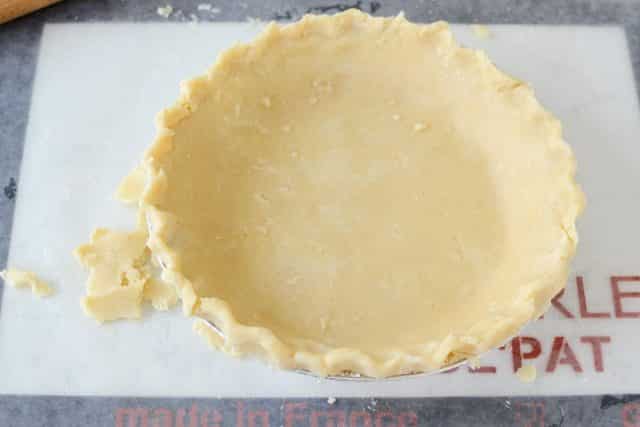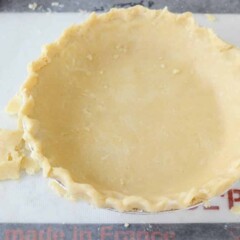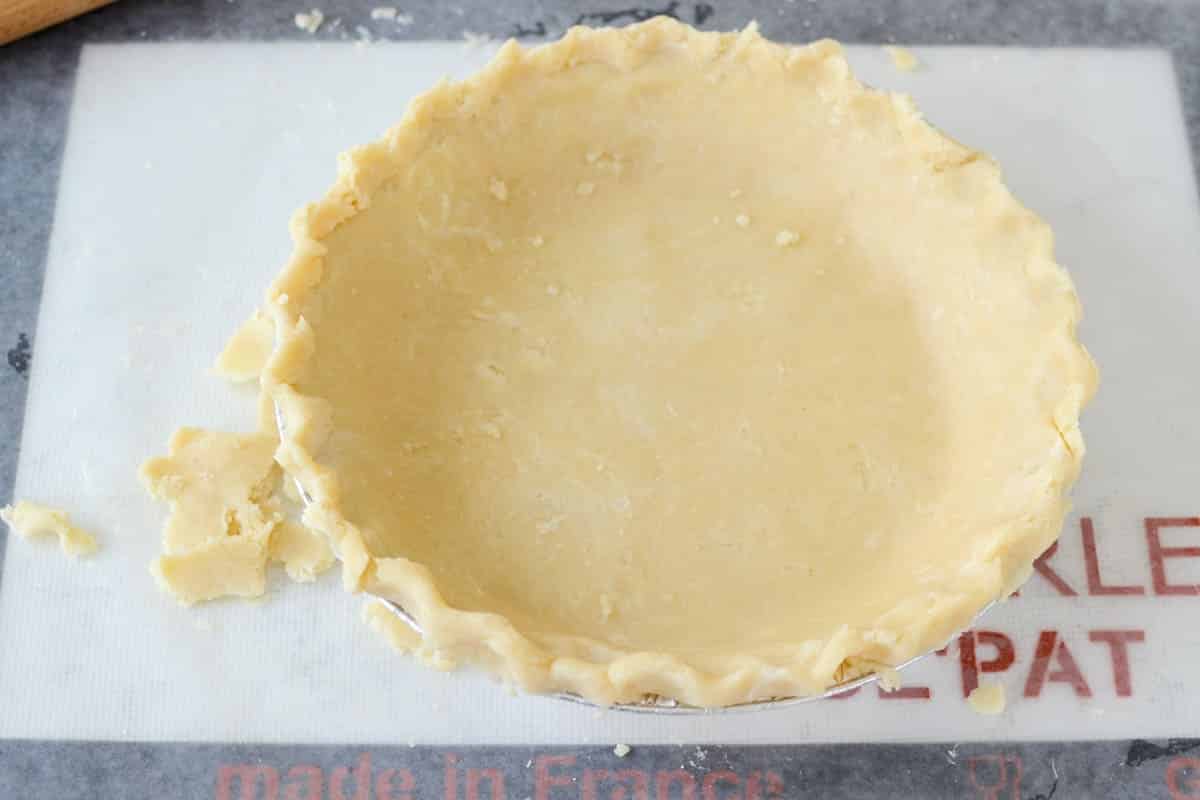This post may contain affiliate links. For more information, read my disclosure policy.
A Butter Shortening Pie Crust is the happy medium between an all butter pie crust and an all shortening crust. It has the flakiness of shortening and the flavor of butter, making it a perfect pie crust recipe.

There is an age old debate about using butter or shortening in a pie crust. Which is better? Which is flakier?
Honestly, it’s just about taste. I didn’t find that an all shortening crust was any flakier than an all butter crust. Maybe it was marginally, but the shortening crust lacks flavor. I often wonder if the people who say they hate pie crust are eating shortening crusts – they’re boring and one dimensional.
While all butter pie crusts are my preference, I will sometimes try to satisfy family members who swear by shortening crust. To do this I made a half and half recipe out of my favorite butter crust. The result is something that’s (a teeny bit) flakier but has the delicious, rich, and multi-dimensional flavor of butter in the crust. While I still prefer all butter, this is a nice medium between the two.
Butter Shortening Pie Crusts are the happy medium between an all butter and all shortening crust.
Read all about the secret to making the perfect pie crusts here.
Ingredients:
- Cold Butter – make sure your butter is rock solid cold, and use real butter (not margarine or low-fat).
- Shortening – you can use Crisco or lard if you want
- Ice Water – keep it cold!
- Flour – I always use all purpose flour for my pie crusts.
Method:
- You can do this by hand, with a pastry cutter. That’s the old school way.
- I love using a food processor because it’s easy!
- Don’t forget to chill it! You have to chill a crust with shortening for a long time because it’s not 100% solid at room temperature.
- I like to roll out my crust between two sheets of wax paper and put it in the pie plate, then chill it.
Special Equipment:
- 9” pie plates
- Rolling Pin
- Pastry Cutter
- Roul’Pat or other silicone surface for rolling
- Food Processor if you want to go that route.
- Wax Paper to make it easier to roll out your crust without chilling first.
- Foil or Pie Crust Shield for protecting the edges of your crust during baking.

Butter Shortening Pie Crust
Ingredients
- 1 1/4 cups all-purpose flour
- 1/4 teaspoon salt
- 1/4 cup cold unsalted butter diced
- 1/4 cup cold vegetable shortening
- 1-3 tablespoons ice water
Instructions
Food Processor Directions:
- Place flour and salt in the bowl of a food processor. Pulse once to combine.
- Add the butter and shortening and pulse a few times to work them throughout the flour.
- Add 1 tablespoon of water and run the food processor until the dough comes together, adding more water as needed. (I always use 2 tablespoons.)
- Turn out dough onto a sheet of wax paper and form it into a disk. Top with another sheet of wax paper and roll into a circle that’s about 12” diameter and 1/4” thick. Lift wax paper from the top to loosen, then replace and carefully flip the crust and do the same with the bottom wax paper.
- Carefully transfer the crust to your pie plate and crimp edges as desired. Chill until ready to use.
By Hand Directions:
- Place flour and salt in a large bowl, whisk to combine.
- Add the butter and shortening and work it into the flour using a pastry cutter or two forks until the mixture resembles small peas.
- Add 1 tablespoon of water and continue working the dough until it comes together, adding more water as needed.
- Turn out dough onto a sheet of wax paper and form it into a disk. Top with another sheet of wax paper and roll into a circle that’s about 12” diameter and 1/4” thick. Lift wax paper from the top to loosen, then replace and carefully flip the crust and do the same with the bottom wax paper.
- Carefully transfer the crust to your pie plate and crimp edges as desired. Chill until ready to use.
- For a baked pie: fill according to pie directions and bake as directed.
- For a filled pie: poke the bottom and sides of very cold crust with the tines of a fork several times. Bake at 400°F for 11-14 minutes until cooked through and slightly golden brown.
- For a double crust or lattice pie: double the recipe, splitting the dough ball in two before rolling it out. Chill the top layer for about 10-15 minutes or until it’s firm but still workable before adding it to the top of the pie.

Thanks for the detailed instructions. Hope I did it right🤞
Definitely delicious
This crust works well for my pies. Some comments say it is very crumbly — I have found that I need to use a little more water than the recipe lists to get it to start to form a ball — I add some to the food processor, pulse a couple of times, then check to see if I can pinch it and have the particles stick together. I think my best results are after I get it to start to hold together, I form it into a ball, flatten to a disc, then wrap tightly in cling wrap and put that in the fridge for an hour or so. This lets the moisture hydrate the flour. THEN I take it out and roll it into a circle for the crust, and it’s much more manageable.
I thought this was a very good pie crust. BUT I looked up what 174kcal equals to our calories, OH MY GOSHHHHH. It is
175 Kilocalorie (thermochemical) = 174882.96551 Calorie (international)
THAT IS A LOT. Like 174,882.96
I made crust treats with frosting out of it.
kcal is what is used for dietary calories. 1 kcal is 1 dietary calorie.
Wow, this may be the worst pie crust recipe I have ever tried. The flavor was okay but the texture impossible to work with.
This is a great pie crust! Nice and flaky. No after taste as in so many pie crust. I have made it for pumpkin, apple, blueberry and pot pie. Each time my family bragged about the great taste.
Featured In
Rate This Recipe
Recipe Ratings without Comment